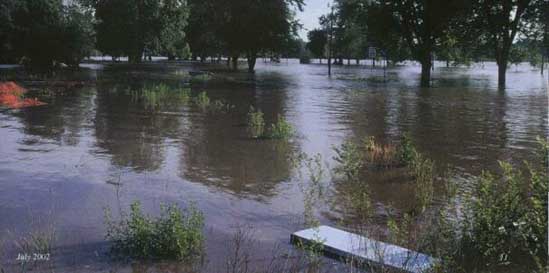 |
Home | Search | Browse | About IPO | Staff | Links |
 |
Home | Search | Browse | About IPO | Staff | Links |
|
Rain, Rain, Go Away . .
From young minds flow great ideas.
STORY AND PHOTOS In 1993, a historic flood wrought havoc on many river communities in Illinois. Lives were lost, families were displaced and their properties destroyed. Two years later, the pattern nearly repeated itself as deluges sent torrents of water through the same river systems. After the disasters, many devastated communities opted to enroll in federal and state buyout programs through the Federal Emergency Management Agency (FEMA) and Illinois Emergency Management Agency (IEMA) which bought flood-prone properties and moved affected owners off the floodplain. But this left many communities with large expanses of open, unused properties. The city of Petersburg was one community that worked with FEMA, DNR and IEMA to buy out its flood-prone properties. Unfortunately, due to a financially strapped budget, it could do little toward development. The property sat idle until 1998, when a member of the Petersburg city council approached the PORTA Community Problem Solvers program (CmPS), which is affiliated with the local high school. The organization was asked to create and implement a plan for the property while still meeting federal and state regulations on the development of the vacant area. CmPS organizers, PORTA high-school teachers Mary Mies and Aneita Gates proposed the idea to the students

12 OutdoorIllinois
who accepted the challenge and worked to develop grassroots support through the community. The group canvassed citizens for ideas about recreation that would be economically feasible while still conforming to state and federal regulations. A community park and preschool playground were ideas that met these criteria. With only pocket change for a budget, the group put together a long-term plan to raise money for these improvements. Through innovative fund-raising projects like the "Decorate an Abe" contest, historic Petersburg place mat sales, charity auctions and Lincoln bear sales, the group not only gained financial support, but also raised community awareness about the historic and aesthetic value of the older section of town. It had deteriorated into an eyesore, but now had a promising future. The community responded with donations, volunteer help and moral support for the youth and their project. A well-timed publicity campaign attracted the eyes and ears of Illinoisans. And triumphs at state and international Future Problem Solvers competitions in 1998, 2000 and 2001 brought national attention to the small town of Petersburg. Gates and the students developed an interactive computer program, and the students gave polished educational presentations about their project to private groups and governmental agencies. With the help of Ron Davis of the Illinois Emergency Management Agency and Paul Osman of DNR's Office of Water Resources, the group navigated the numerous forms and grant applications, met deadlines and located corporate, private and government funding sources to help the group advance toward their monetary goals. Impressed with the progress of the group and their ability to rally the community around their cause, representatives from IEMA, FEMA and the Association of Flood Plain Managers asked the CmPS to present its project at conferences in 2000 and 2001. The presentations were warmly received, and the group's efforts were praised as a model for other communities across the country. The attendees even passed the hat to donate money toward the cause.
12 OutdoorIllinous
Conference attendees encouraged the group to contact local legislators to help with funding and support. Representative Raymond Poe and Senator Larry Bomke responded by obtaining a $50,000 Department of Community and Commerce Affairs grant on behalf of the CmPS, The check was presented by the legislators to the group after their 2001 international victory in the problem-solving competition. The grant, along with the funds raised from the community activities, more than met the goals for the park and pre-school playgrounds. The CmPS group also obtained another parcel of flood plain near their park, which they co-manage with the high school science club as a wild-flower and prairie restoration area. The park itself consists of bottomland trees that can withstand occasional inundations, ornamental garden boxes, a fountain and aesthetically pleasing green areas, complete with paved paths. The park was designed to handle flooding with minimal damage. In the spring of 2002, the pre-school playground equipment—the last phase of the project—was to be installed. But construction was delayed by a familiar visitor—the Sangamon River. Rainfall totaling nearly 20 inches in April and May once again sent the river out of its banks to near record crests. "It was a big test for our project" Mies stated. "The entire park was swallowed by the flood, along with the grove of trees and the prairie grass restoration area." As the water receded, the park and the plant life reappeared, a little muddy, but alive and intact. Outside of the need for some cleanup and minor repairs, the damage was minuscule. Instead of displaced families, damaged property and another disaster area, a community park emerged from the flood—exactly as planned by the CmPS. At press time, the pre-school playground was almost finished and ready to host the familiar squeals of delight from rambunctious children.
"I'm not sure what we'll do next. That will be up to the kids," Mies said. "Aneita and I are very proud of what they have accomplished." If you happen to be traveling through Petersburg, stop by the park just north and west of the Route 123 bridge to witness the achievements of a small group of students. And keep an eye on the future to see how this project will influence the world of community-based floodplain management.
Editor's note Congratulations to the PORTA CmPS on its 2002 Grand Champion victory at the. International Problem Solvers Competition in June.
July 2002 13 |
|
|